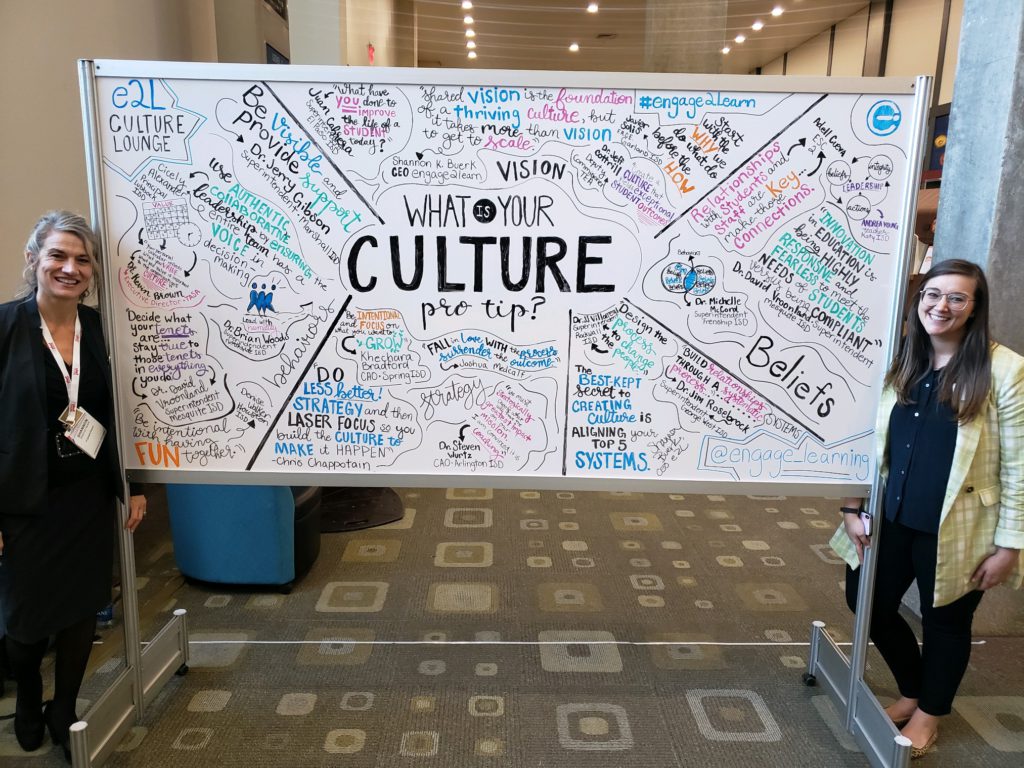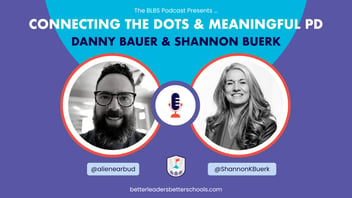4 Things Ed Leaders Can Do to Influence School Culture
We know that the leader influences the culture of an organization more than any other factor, whether they realize it or not. In fact, 70% of the variance between lousy, good, and great cultures can be found in the knowledge, skills, and talent of the team leader (source).
So, we thought it would be beneficial to poll the visionary leaders in our state who are catalysts for positive school culture in their organizations and share some of that knowledge. At TASA Midwinter Conference last month, we hosted a Culture Lounge where we asked Texas superintendents, cabinet-level leaders, and campus leaders to share their pro tips on culture.

At engage2learn (e2L), we began studying organizational culture several years ago when, as a strategic planning facilitator, we got to see firsthand when “culture ate strategy for breakfast” in districts.
To learn more about how to help districts address this culture challenge, we formed a partnership with Friends of Texas Public Schools. We offered an academy we called “Game Changers,” where we went to the headquarters of innovative businesses like Southwest Airlines, Google, The Container Store, Rackspace, TD Industries, Steelcase, Uber, and Whataburger. We learned from the C-suite of these organizations about what they were doing to create clarity of cultural expectations. These leaders aren’t just accepting the default culture. Instead, they understand that creating culture is the true calling of a leader, and they spend the majority of their time focused on that role.
As David J. Barger, former President and CEO of JetBlue says, “I spend 50% of my time on culture.” Perhaps that is why they are continuously ranked highly among the best companies for which to work!
Tom Kuppler, the founder of Culture University, echoes this sentiment: “Top leaders will be viewed as financially and morally negligent if they don’t understand their culture and deal with what they find.” What are those leaders doing to create culture? After studying these innovative CEOs, we discovered some key components that can be transferred to educational organizations, and these ideas were echoed by Texas leaders we polled at Midwinter. Here is a summary of some of the actionable ideas that you can apply in your district:
01: Collaborate with stakeholders to create a local vision for your organization. Many organizations have put this in place already! What is your call to action?
- Culture Lounge Quote:
- “Shifting culture begins with a clear vision developed by all stakeholders with a defined learning framework now being followed with personalized coaching and support. Our roadmap began with a clear vision developed by all stakeholders with a defined learning framework, now being followed with personalized coaching and support. We are early in the process, but you can already hear and see the tide shifting.” -Cara Cook, Superintendent, Aransas Pass ISD
- Resources:
- Here are some Focus Group Questions to get you started on engaging stakeholders in defining your vision. If you are really ambitious and the timing is right for a full-blown strategic plan, we have partnered with TASA to offer this Strategic Vision DIY.
02: Clarify the measurables and ideal behaviors that align to that vision. One thing we noticed when studying the Game Changer organizations is that they did not leave culture to chance. They all had cultural tenets that clarified the expectations for behaviors.
- Quotes:
- “Model and measure what you value because your organizational culture will align to what you do more than what you say.” – Shannon Buerk, CEO e2L
- “Cultural change in an organization begins with the leader. Elevating the voice of teachers and students, establishing trust, and collaborating to establish a common vision are all fundamental to a positive culture, but they are not sufficient. Schools don’t magically “transform” on their own, nor do they transform just because the leader communicates that she wants them to do so. Transformation occurs when the leader dramatically alters her role. As simple as it seems, this begins with your calendar. Your personal calendar as a leader reflects what you value, and what you value is important to the organization’s culture. If you value people, you spend time with people. If you value learning, then you prioritize your own learning as well as the learning of your team. Identify what you value, and then ask yourself, ‘Is what I value reflected in my personal calendar?’” – Dr. Kevin Brown, Executive Director, TASA
- Resources:
- Creating clarity through cultural tenets helps leaders and everyone else in the organization check behaviors. Arlington ISD has used the Cultural Tenets process to create an amazing example that has been rolled out to everyone in the district. See their Cultural Tenets here. To get you started, here is a blog on how to create Cultural Tenets, and here is a link to the landing page for the DIY on Culture Vision and Community Based Accountability we offer with TASA. Finally, we have a Culture Design Bootcamp that we are offering with TASA on a first-come, first-served basis for 2020.
03: Codify the ideal behaviors into systems that will reinforce the culture to make that vision a reality. This is where culture can wear down strategy. For example, a district has a vision for collaborative, future-ready classrooms, but continues to subject adults to boring, lecture-style meeting systems. Why not align the meeting systems to the behaviors desired to modernize the learner experience?
- Quotes:
- According to Chip Heath in How to Change When Change is Hard, “Until you can ladder your way down from a change idea to a specific behavior, you’re not ready to lead a switch” (2010).
- “Anyone can say ‘kids are top priority’ but show me how your team culture is driven by this statement. How about asking your team every day, ‘what have you done to improve the life of a student today?’ ” Superintendent, El Paso ISD
- “Once shared beliefs are firmly established, they serve as a beacon to light the path to shifting culture. A word of caution, based on experience, you must be intentional to ensure behaviors are consistent with your shared beliefs. It is easy to get distracted.” –Dr. Michelle McCord, Superintendent, Frenship ISD
- Resources:
- To get you started, here is a very powerful Beliefs to Behaviors Workspace we created. Also, here is a blog about how to align one of your critical systems to your ideal culture: 5 Ways to Make Meetings Matter.
04: Coach everyone in the organization as they shift culture and practice to align to the vision and enhance their craft to truly innovate in schools. Do you want more than just a handful of people in your organization to be engaged in the vision? You can change your entire organization by just taking all the time and money allocated to programs and training and converting that to investing in individualized, job-embedded coaching. If you haven’t seen the stats, note that if you don’t invest in coaching, you are basically flushing time and money for training down the drain.

Besides making the organizational vision a reality through implementation, coaching saves the organization money by increasing the retention of talent. In fact, 94% of employees would stay in their current role longer if they felt the organization invested in their professional development (source), and 78% of Gen Xers believe performance reviews are formalities that do not offer constructive opportunities for growth (source). Coaching provides employees the support and feedback they crave.
- Quotes from the Culture Lounge:
- “As leaders, we have limited resources and must strategically choose what will have the greatest impact on our mission. I am convinced it is coaching. No other strategy has the has as much potential to positively alter lives, improve learning and rapidly increase outcomes for kids than providing system-wide job-embedded coaching focused on research-based best practices.” – Dr. Steven Wurtz, Chief Academic Officer, Arlington ISD
- “Innovation in education is being highly responsive and fearless to meet the needs of students versus being compliant. Being innovative is not about invention. It’s about doing what is best for our schools. We are moving from being fearful to being fearless.” – Dr. David Vroonland, Superintendent, Mesquite ISD
- Resources:

Call to Action:
What are the three things you will implement in 2020 to influence the culture of your organization?



